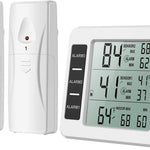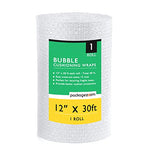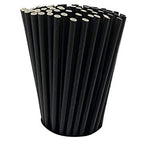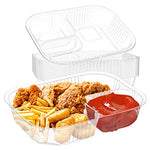You have no items in your shopping cart.
When it comes to garbage bags, finding the right size and considering sustainable alternatives has become increasingly important. In this comprehensive guide, we'll delve into the details of garbage bag sizes, sustainable replacements for single-use bags, alternative options to plastic, and factors to consider when selecting the appropriate thickness. Additionally, we'll explore different bin sizes and clarify the distinction between bin liners and garbage bags.
What are the Sizes of Garbage Bags?
Garbage bags come in various sizes to accommodate different bin capacities. The most common sizes include:
-
Small (4-8 Gallons): These bags are suitable for small wastebaskets in bathrooms, bedrooms, or offices.
-
Medium (12-16 Gallons): Ideal for kitchen or office wastebaskets, these bags provide slightly larger capacity.
-
Large (20-30 Gallons): Designed for larger indoor bins or outdoor trash cans, these bags are commonly used in kitchens or for general household waste.
-
Extra Large (33-45+ Gallons): These bags are perfect for large outdoor bins or commercial use, accommodating substantial amounts of waste.
Keep in mind that specific brands may have slight variations in size options. It's essential to consider your bin's capacity and select a bag size that allows for easy installation and removal.
What Will Replace Single-Use Garbage Bags?
As the world focuses on sustainability, single-use garbage bags are being replaced by more environmentally friendly options. Some alternatives to single-use garbage bags include:
-
Reusable Cloth Bags: Made from durable materials like canvas or nylon, reusable cloth bags are an excellent choice for waste disposal. They can be washed and used repeatedly, reducing the need for single-use bags.
-
Biodegradable Bags: These bags are designed to break down more easily in landfill conditions. They are typically made from plant-based materials or plastics that degrade over time, minimizing environmental impact.
-
Compostable Bags: Compostable bags are specifically designed to be composted along with organic waste. They break down into natural elements, contributing to nutrient-rich compost.
-
Paper Bags: Paper bags are an eco-friendly alternative for certain types of waste. They can be easily recycled or composted and are an excellent option for dry or non-messy waste.
Remember to check local regulations and recycling programs to ensure proper disposal of these alternative options.
What Can I Use Instead of Plastic Garbage Bags?
If you're looking to avoid plastic garbage bags, consider the following alternatives:
-
Biodegradable or Compostable Bags: These bags are made from plant-based materials and break down naturally over time, reducing their environmental impact.
-
Reusable Cloth Bags: Durable and washable, reusable cloth bags offer a long-lasting alternative to plastic garbage bags.
-
Paper Bags: When suitable, paper bags can serve as an eco-friendly substitute. They can be recycled or composted, making them a more sustainable choice.
-
No Bag Method: For some waste, such as dry or non-messy items, you may opt to place them directly in the bin without using a bag.
Consider your waste disposal needs and environmental concerns when selecting the best alternative to plastic garbage bags.
What are 3 Alternatives to Plastic Bags?
In addition to garbage bags, plastic bags used for shopping or general purposes are being replaced with more sustainable options. Here are three alternatives to plastic bags:
-
Reusable Shopping Bags: These are sturdy, multi-purpose bags made from materials like canvas, jute, or recycled plastic. They can be used repeatedly for shopping trips, reducing the need for single-use plastic bags.
-
Mesh Produce Bags: Instead of using thin plastic bags for fruits and vegetables, opt for reusable mesh produce bags. They allow for breathability while keeping your produce organized.
-
Silicone Food Storage Bags: Replace single-use plastic food storage bags with reusable silicone bags. These are airtight, durable, and can be used for storing leftovers or carrying snacks on-the-go.
By making small changes in our daily habits, we can significantly reduce our reliance on single-use plastic bags.
How Thick Should Garbage Bags Be?
The thickness of garbage bags is an important consideration to ensure they can handle the weight and sharp edges of the waste. The appropriate thickness depends on the type of waste you typically dispose of. Here are some general guidelines:
-
Light to Medium Waste: For regular household waste, a bag thickness between 0.7 to 1.2 millimeters (mils) is usually sufficient.
-
Heavy or Sharp Waste: If you often dispose of heavy or sharp waste, opt for thicker bags with a thickness of 1.5 mils or more. These bags provide extra strength and reduce the risk of tearing or leakage.
Remember to choose a thickness that suits your specific needs and consider the intended use of the bag.
Explore our premium selection of trash bags designed to meet all your waste disposal needs. Whether you're looking for durable kitchen trash bags or heavy-duty options for industrial use, we've got you covered. Click the green button to discover high-quality bags that combine strength and reliability. Make your waste management hassle-free with our top-notch collection.
How Do I Know My Bin Bag Size?
To determine the appropriate bin bag size, follow these steps:
-
Measure the Bin: Measure the height, width, and depth of your bin using a tape measure.
-
Calculate the Volume: Multiply the three measurements together to calculate the volume of your bin in cubic inches or liters.
-
Choose the Bag Size: Refer to the size specifications provided by the manufacturer or retailer to select a bag size that comfortably accommodates your bin's volume.
It's important to note that the actual capacity of a garbage bag may vary depending on the bag's shape and design. Consider choosing a bag slightly larger than your bin's calculated volume to ensure a secure fit.
How Big is a 75L Garbage Bag?
A 75-liter garbage bag is designed to hold approximately 75 liters of waste. It is typically used for larger bins or outdoor trash cans. The dimensions of a 75-liter garbage bag can vary slightly depending on the brand, but a common size is approximately 30 inches (76 cm) wide by 40 inches (102 cm) tall.
What is the Size of XXL Garbage Bag?
The term "XXL" can vary between different brands, so it's essential to check the specific dimensions provided by the manufacturer. However, an XXL garbage bag generally refers to an extra-large size suitable for larger bins or heavy-duty use. It may have dimensions around 36 inches (91 cm) wide by 48 inches (122 cm) tall or larger.
How Thick is a Costco Garbage Bag?
Costco garbage bags are known for their durability and strength. The thickness of Costco garbage bags typically ranges from 1.2 to 2 mils, depending on the specific product line. These thicker bags provide enhanced puncture resistance and can handle heavier loads.
How Many Liters are Costco Garbage Bags?
The capacity of Costco garbage bags can vary depending on the specific product. They offer a range of sizes suitable for different needs, from smaller bins to larger outdoor containers. Costco garbage bags can have capacities ranging from 30 liters to 85 liters or more.
What is the Difference Between a Bin Liner and a Garbage Bag?
Bin liners and garbage bags serve similar purposes but have slight distinctions:
-
Bin Liner: A bin liner is specifically designed to fit snugly inside a bin or waste container. It acts as a lining to collect and contain the waste, making it easier to empty and clean the bin. Bin liners are often available in various sizes and thicknesses to suit different bin capacities.
-
Garbage Bag: A garbage bag is a more general term used to refer to bags used for waste disposal. While they can also be used as bin liners, garbage bags are not always designed to fit a specific bin size. They come in various sizes, thicknesses, and types to accommodate different waste disposal needs.
What are the Different Bin Sizes?
Bins come in various sizes to cater to different waste volumes. Common bin sizes include:
-
Small Bins: Ranging from 5 to 10 gallons, small bins are typically used in bathrooms, bedrooms, or offices.
-
Medium Bins: With capacities of 12 to 30 gallons, medium bins are suitable for kitchens, common areas, or smaller households.
-
Large Bins: Large bins can hold 30 to 50+ gallons and are commonly used for outdoor trash cans or in commercial settings.
Keep in mind that bin sizes may vary between manufacturers or regions. It's important to choose a bin size that matches your waste generation and fits well within your space.
What Size is a Normal Bin?
A "normal" bin size can vary depending on the context and location. In many households, a normal bin is typically considered to be a medium-sized bin with a capacity of around 12 to 16 gallons. However, what is considered normal may differ based on specific needs, household size, and waste generation.
By understanding garbage bag sizes, exploring sustainable alternatives, and considering bin dimensions, you can make informed decisions about waste disposal that align with your needs and environmental values.






















![100% Compostable 9 Inch Paper Plates [125-Pack] Heavy-Duty, Natural Disposable Bagasse Plate, Eco-Friendly Made of Sugarcane Fibers - Natural Unbleached Brown 9" Biodegradable Plate by Stack Man](http://www.trashrite.com/cdn/shop/products/418LbW6FSUL_150x150_crop_center.jpg?v=1689802541)
